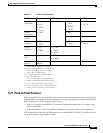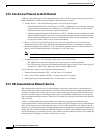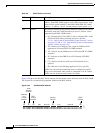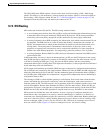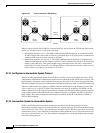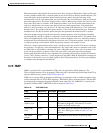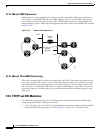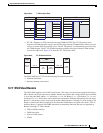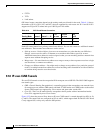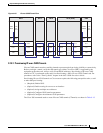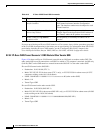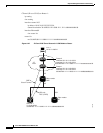
9-35
Cisco ONS 15600 Reference Manual, R7.2
Chapter 9 Management Network Connectivity
9.7.5 TARP
•
Type— Indicates whether the TARP PDU was created through the TARP propagation process
(dynamic) or manually created (static).
Provisionable timers, shown in Table 9-12, control TARP processing.
Table 9-13 shows the main TARP processes and the general sequence of events that occurs in each
process.
9.7.5.2 TARP Loop Detection Buffer
The TARP loop detection buffer (LDB) can be enabled to prevent duplicate TARP PDUs from entering
the TDC. When a TARP Type 1, 2, or 4 PDU arrives, TARP checks its LDB for a NET address (tar-por)
of the PDU originator match. If no match is found, TARP processes the PDU and assigns a tar-por,
tar-seq (sequence) entry for the PDU to the LDB. If the tar-seq is zero, a timer associated with the LDB
entry is started using the provisionable LDB entry timer on the node view OSI > TARP > Config tab. If
a match exists, the tar-seq is compared to the LDB entry. If the tar-seq is not zero and is less than or
equal to the LDB entry, the PDU is discarded. If the tar-seq is greater than the LDB entry, the PDU is
processed and the tar-seq field in the LDB entry is updated with the new value. The ONS 15600 LDB
holds approximately 500 entries. The LDB is flushed periodically based on the time set in the LDB Flush
timer on the node view OSI > TARP > Config tab.
Table 9-12 TARP Timers
Timer Description
Default
(seconds)
Range
(seconds)
T1 Waiting for response to TARP Type 1 Request PDU 15 0–3600
T2 Waiting for response to TARP Type 2 Request PDU 25 0–3600
T3 Waiting for response to address resolution request 40 0–3600
T4 Timer starts when T2 expires (used during error recovery) 20 0–3600
Table 9-13 TARP Processing Flow
Process General TARP Flow
Find a NET that
matches a TID
1.
TARP checks its TDC for a match. If a match is found, TARP returns the
result to the requesting application.
2.
If no match is found, a TARP Type 1 PDU is generated and Timer T1 is
started.
3.
If Timer T1 expires before a match if found, a Type 2 PDU is generated and
Timer T2 is started.
4.
If Timer T2 expires before a match is found, Timer T4 is started.
5.
If Timer T4 expires before a match is found, a Type 2 PDU is generated and
Timer T2 is started.
Find a TID that
matches a NET
A Type 5 PDU is generated. Timer T3 is used. However, if the timer expires, no
error recovery procedure occurs, and a status message is provided to indicate
that the TID cannot be found.
Send a notification
of TID or protocol
address change
TARP generates a Type 4 PDU in which the tar-ttg field contains the NE’s TID
value that existed prior to the change of TID or protocol address. Confirmation
that other NEs successfully received the address change is not sent.



